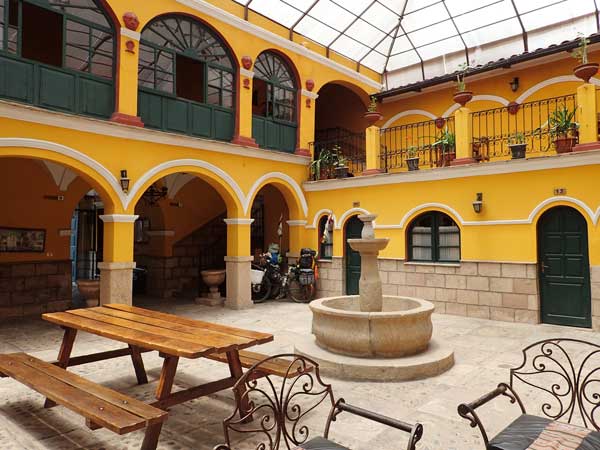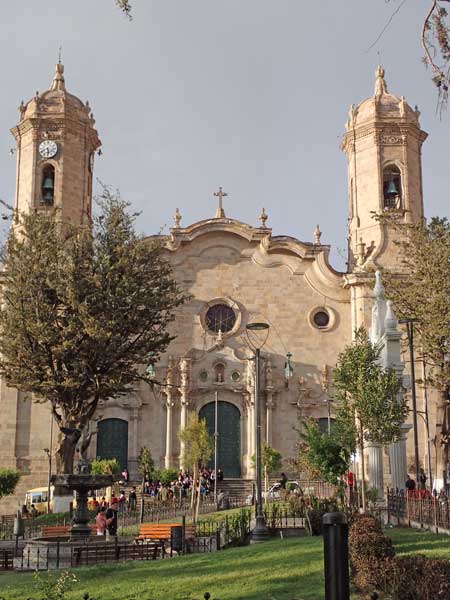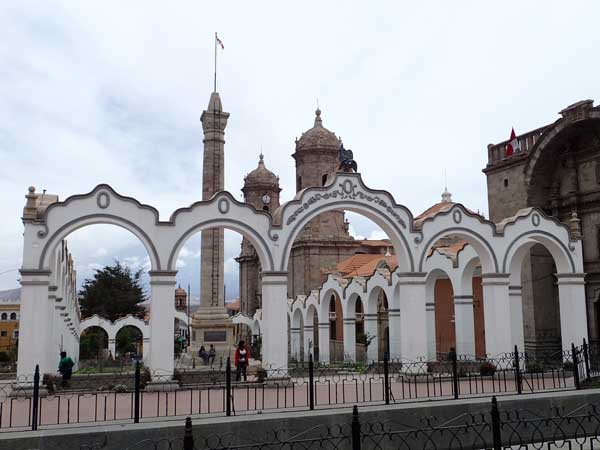Potosí

Caramor - sailing around the world
Franco Ferrero / Kath Mcnulty
Mon 13 Nov 2017 02:42
19:35.22S 65:45.13W The taxi dropped us off in the main square, the rain had been torrential but was slowly easing. It was mid afternoon and we hadn’t eaten lunch so were becoming a little grumpy, especially when we couldn’t find the ‘cheap’ hotel the Dutch guy in Sucre had recommended. In the end we marched into the first hostel we passed. It was remarkably good value so we took a room. (Later we found the ‘cheap’ hotel, the most expensive in town!)  The inner courtyard of our hostel in Potosí Potosí is one of the highest cities in the world (4,067m). It was founded in 1545 by Spanish colonists as a mining town to exploit the rich silver deposits of Cerro Rico, the ‘rich mountain’. The silver was carried by llama and mule all the way to the Pacific coast where it was shipped north to Panama City, and carried across the isthmus to be taken to Spain.  Cerro Rico, the silver mine The miners were mostly native conscripts forced to work through the ‘mita’ system. This tradition dated from the Inca period. All male citizens from the age of 15 until the age of 50 were required to work for the state a set number of days per year. They built the structures and highways the Inca Empire is famous for. In exchange for a man’s labour, his family was taken care of while he was absent and there was an element of social security. If there was a crop failure, food would be provided from stores or another part of the empire. The system was flexible on how much time a person had to devote to the mita and the overseers were responsible for making sure that a man still had enough time to care for his own land and family. The Spanish invaders adopted and corrupted this system. Native communities were required to provide one in seven of their male labour force at any given time for public works, mines and agriculture. Nothing was given in exchange and often the men did not return to the villages, either because they had died or because they had been enslaved. Unlike the Inca mita which was mostly about providing public goods, and where the men worked near their communities, the Spanish system was a subsidy to private mining interests and the Spanish State. Many miners died in the mine, from natural gases, pneumonia caused by the high altitude or mercury poisoning. From around 1600, when Cerro Rico was at its heyday (the cheapest and largest producer of silver in the world) the death rate increased dramatically. To replace the dead native Americans, the mine owners imported an estimated 30,000 Africans slaves, many of which also died from the horrific conditions. In the Spanish colonial period in Potosi, it is estimated that two billion ounces of silver were mined and eight million people died mining it. Today, Cerro Rico mine is still being worked. The labour conditions haven’t changed much and the miners’ life expectancy is very short. Geologists consider the whole mountain to be structurally unsound, we had no desire to visit. Bags dumped in the room, we hurried over to La Moneda, the historical mint of Bolivia. We hoped to catch the late afternoon guided tour.  La Moneda mint The displays were a mixture of religious indigenous art, the process of making coins and the historic building itself, a UNESCO World Heritage Site. The art gallery was of more interest than usual, although purporting to be paintings of Saint This and Saint That, the Virgin Mary was drawn cone shaped, the way the earth goddess Pachamama / Cerro Rico is represented in indigenous art. What struck Franco and I most from the visit, were the horrific working conditions in the mint. The temperature in the forge was 960˚ Celsius and the heat in the building unimaginable. How could humans be expected to work in such high temperatures? And yet they were. Downstairs, the coin making machinery was powered by mules going around and around, harnessed to a mill, and supervised by humans. After two horrific hours, the mules would refuse to go any further so had to be replaced by another team and rested. The humans, however, were forced to work twelve to fourteen hours. Despite their common sense, the mules would still die after a couple of months working the mill. Eventually the colonists replaced each four mule team with twenty African slaves, it was cheaper. It was Saturday night and we set off in search of a nice restaurant. Every other street was pedestrianised which made for pleasant and safe wandering. None of the restaurants we fancied were open but we found a backpackers café which served a great llama steak.  Franco in Potosí  The cathedral  The square  Landscape around Potosí |